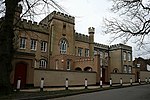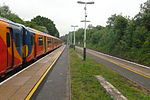Nonsuch Palace

Nonsuch Palace was a Tudor royal palace, commissioned by Henry VIII in Surrey, England and completed in 1538. Its site lies in what is now Nonsuch Park on the boundaries of the borough of Epsom and Ewell in Surrey and the London Borough of Sutton. The palace was designed to be a celebration of the power and the grandeur of the Tudor dynasty, built to rival Francis I's Château de Chambord. Unlike most of Henry's palaces, Nonsuch was not an adaptation of an old building; he chose to build a new palace in this location because it was near to one of his main hunting grounds. However the choice of location was unwise, as there was no nearby supply of water suitable for domestic use. The palace remained standing until 1682–3, when it was pulled down by Barbara, Countess of Castlemaine, mistress to Charles II, to sell off building materials to pay for her gambling debts.
Excerpt from the Wikipedia article Nonsuch Palace (License: CC BY-SA 3.0, Authors, Images).Nonsuch Palace
The Avenue, Epsom and Ewell Stoneleigh
Geographical coordinates (GPS) Address Nearby Places Show on map
Geographical coordinates (GPS)
| Latitude | Longitude |
|---|---|
| N 51.354444444444 ° | E -0.23833333333333 ° |
Address
The Avenue
The Avenue
KT17 2DN Epsom and Ewell, Stoneleigh
England, United Kingdom
Open on Google Maps







